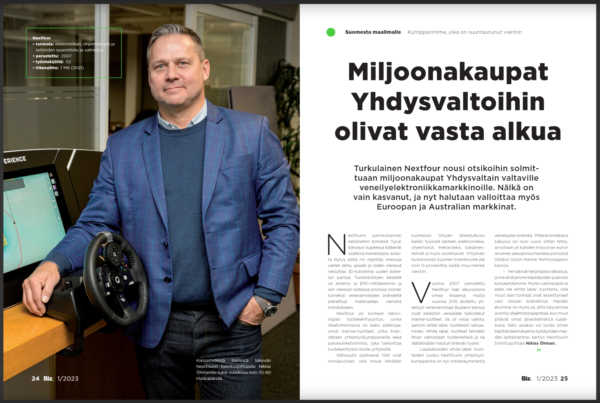Finland’s first LTE-M and NB-IoT supported IoT (Internet-of-Things) application platform has been launched in the city of Turku. The application is a collaboration between Nextfour Group, one of the leading product development companies in the South-Western Finland, and DNA, one of the leading telecommunications groups in Finland.
Developing a scalable high-performance platform is essential to providing companies with the best IoT solutions in the future. Moving on to 5G network will only increase the platform’s importance, as 5G makes it possible to extend the current IoT services.
This is one of the reasons why Nextfour conducted an extensive research project on two upcoming technologies: Narrowband-IoT (NB-IoT) and LTE Cat M1 (LTE-M) during the winter 2017 – spring 2018. DNA provided Nextfour’s team with a test network, making it possible for them to create and test prototypes locally in Turku.
Both NB-IoT and LTE-M utilize the Low-Power Wide-Area network (LPWAN). Nextfour’s study found that by using Low-Power Wide-Area network standards set by 3GPP, it is possible to respond to market’s growing needs while keeping production costs low.
Leader of the project team at Nextfour, Teemu Peltola explains the project’s background:
“Demand for autonomous devices has increased significantly during the past few years and the trend is likely to continue in the future. This means that sensors and ways to communicate with them need to develop too. To stay on top of Machine to Machine (M2M) technologies, Nextfour, in cooperation with DNA, has made significant research on two upcoming technologies that can help us expand and optimize operation in this field.”
Nextfour now has a scalable prototype application platform with cloud-based server services. Application will be utilized in the future as a basis for developing customer solutions.
NB-IoT and LTE-M haven’t gone unnoticed by the local operators that are now launching low-price data subscriptions to meet the growing volume demands. Additionally, the forthcoming 5G network infrastructure releases old network capabilities enabling operators to offer high performance solutions with transcendent geographical coverage.
Both technologies use the existing carrier infrastructure, which means that carrier rollout in effect would consist of deploying software updates to the base stations. This will keep infrastructure costs down in comparison to some other LPWA networks. These technologies can be considered an add-on to existing networks, not as entirely separate networks.
The biggest differences between NB-IoT and LTE-M are data rates and mobility. NB-IoT is more suitable for static sensors, e.g. humidity sensor in a building, while LTE-M can be used in moving vehicles like cars and lorries.
Some of the study’s findings are listed below:
Specifics of NB-IoT
- Covers a larger area than traditional cellular technologies also in challenging environments where normal cellular network lacks coverage
- Lower device costs
- Long battery life (10+ years)
- Highly scalable technology, enables much more IoT devices to be connected in same area than traditional cellular networks
- NB-IoT does not support Voice over LTE nor full mobility
- NB-IoT suitable for stationary sensors that require extremely long battery lives
Specifics of LTE-M
- Covers a larger area than traditional cellular technologies
- Lower device costs
- Longer battery life than traditional cellular technologies, but lower than NB-IoT (~5-10 years)
- Supports Voice over LTE and full mobility
- LTE-M suitable for applications that require mobility but with not as high requirements on battery life as NB-IoT
Founded in 2007, Nextfour Group is a hi-tech engineering company with over 10 years of experience on the field. Nextfour specializes in product development for demanding environments such as marine, safety and medical sectors. DNA is an OMX listed operator that has been operational since 2001.




